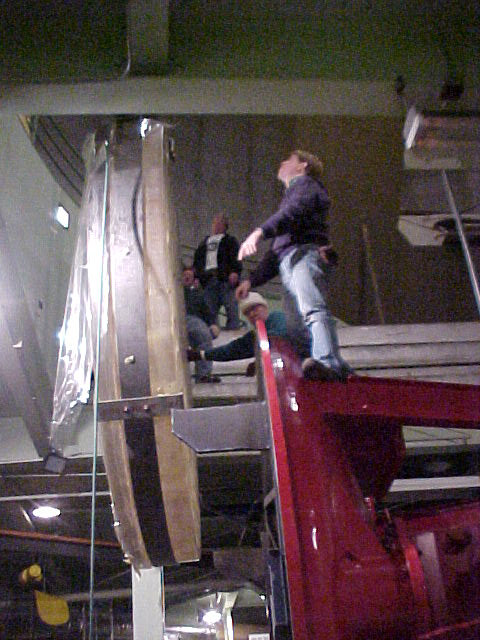UNIVERSITY OF CALIFORNIA OBSERVATORIES / LICK OBSERVATORY

NEXT
UNIVERSITY OF CALIFORNIA OBSERVATORIES / LICK OBSERVATORY | |
 | ALUMINIZING THE 3-METER MIRROR: FEBRUARY 2000 |
| Applying the Coating | BACK NEXT |
 |
 |
| The aluminizing facility is located in the basement of the 3-meter dome, directly below the observing floor. It consists of a massive vacuum chamber, just large enough to accommodate the 3-meter mirror. The chamber is also used for coating many of the other mirrors in Mt. Hamilton's five reflecting telescopes. | Inside the chamber, arrays of filaments are hung with bits of ultra-pure aluminum wire. When a large current is applied to the filaments, the aluminum vaporizes and is deposited, in vacuum, on the glass surface of the mirror. |
 |
 |
| On the left is a filament before being hung with aluminum. On the right the filament has been "loaded." | |
 |
 |
| The mirror, still covered with plastic to protect the surface, is lowered from the observing floor above into the waiting chamber. | Once in the chamber, the plastic is removed and the surface given one last cleaning |
 |
 |
| Finally, the two halves of the chamber are pushed together and bolted. The vacuum pumps are started and the several hours' job of evacuating the chamber is begun. When the required vacuum is achieved, a series of switches are thrown, sending current to the filaments and vaporizing the aluminum in a carefully determined sequence. Air is readmitted to the chamber and, with all involved holding their breath, the tank is reopened and the new coating revealed. | |
 |

At about 7 pm on Tuesday the 15th, the chamber is opened and the new coating seen for the first time. It is carefully examined and declared a success. The coating passes the time honored "Scotch Tape" test, in which a small strip of Scotch Tape is pressed on to the aluminum at the edge of the mirror, and comes free with no metal sticking to it. At left, members of the staff are seen reflected in the new coating. Above, the mirror, still hung in the chamber, is seen from the observing floor, above. The long day ends by closing the chamber on the newly coated mirror. In the morning, the job of reinstalling it in the telescope will begin. |